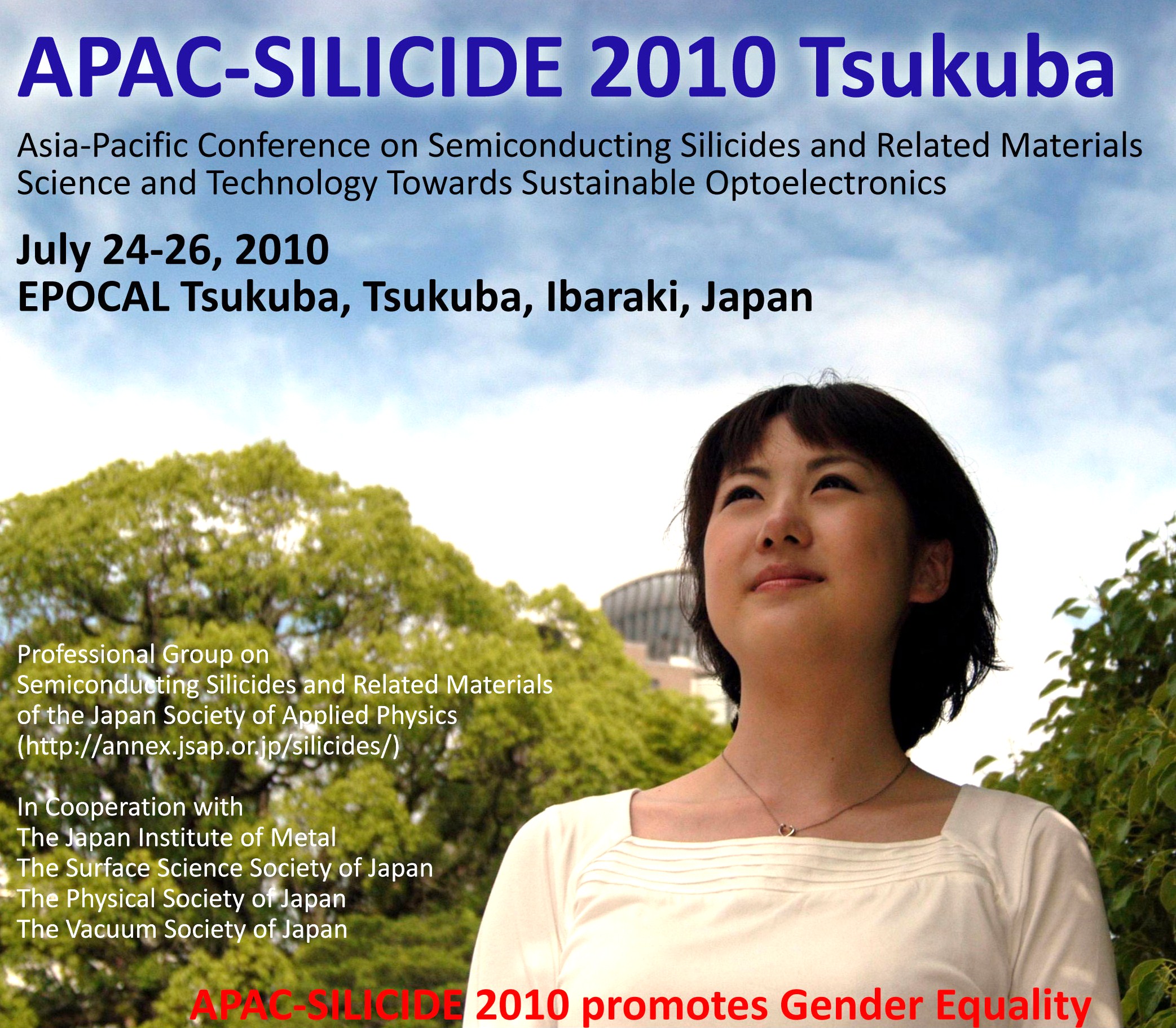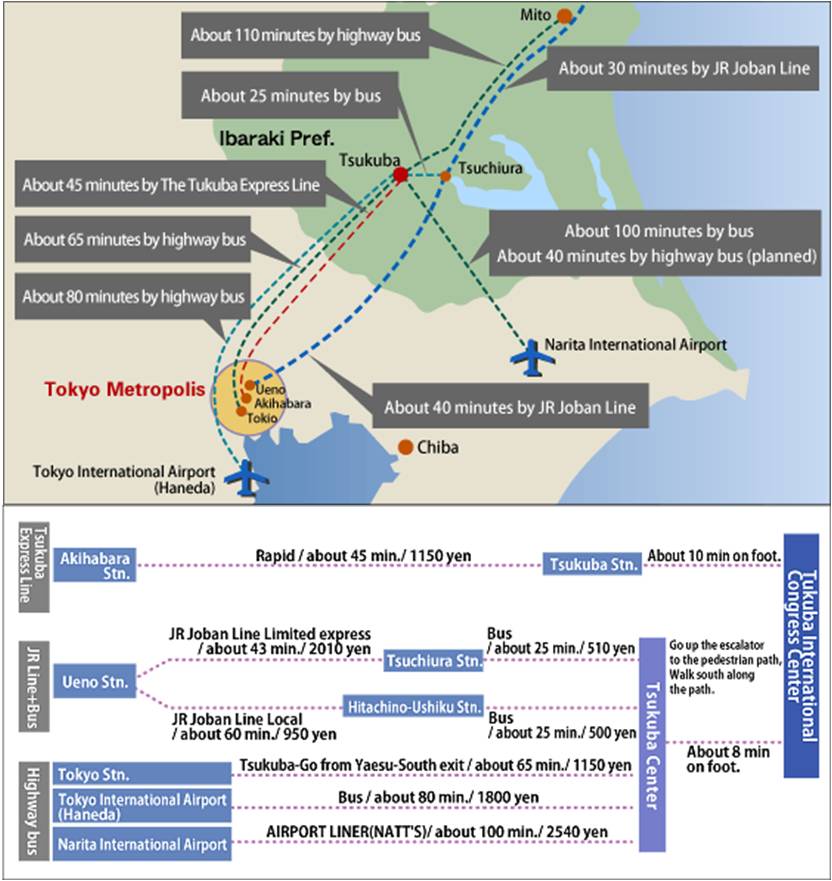
Thank you for the participation in APAC-Silicide 2010 (2010/7/25).
(high-resolution phot is here.)
Conference selected papers have been published in Thin Solid Films.
Selected Papers from the Asia-Pacific Conference on Semiconducting Silicides
Science and Technology Towards Sustainable Optoelectronics (APAC-SILICIDE 2010)
Edited by Y. Maeda, Y. Terai, K. P. Homewood, K. Takarabe, K. Yamaguchi,
T. Sadoh, M. Suzuki, Y. Nakamura
Thin Solid Films 519 (2011) 8433-8538.
(http://www.sciencedirect.com/science/journal/00406090)
Conference Proceedings have been published in Physics Procedia.
Proceedings of
Asia-Pacific Conference on Semiconducting Silicides
Science and Technology Towards Sustainable Optoelectronics (APAC-SILICIDE 2010)
Tsukuba, 24-26 July 2010
Edited by Y. Maeda
Physics Procedia 11 (2011) 1-204.
(http://www.sciencedirect.com/science/journal/18753892)
| Abstract deadline | April 8, 2010 | changed |
| Registration | June 30, 2010 | |
| Paper submission | July 24, 2010 | |
| Conference | July, 24-26, 2010 |
The organizing committee welcomes researchers and students with interests in the science and technology of semiconducting silicides and related materials to ‘APAC-SILICIDE 2010’. The first international meeting on semiconducting silicides was held as the Japan-UK Joint Workshop on Kankyo Semiconductors, Tsukuba, Japan in 2000. Since this new engineering paradigm was launched, research activities on semiconducting silicides have expanded dramatically. The successful research achievements of 2001 were exemplified in a special issue on Silicide Ecologically Friendly Semiconductors: Optoelectronic and Energy Research for next Generation, Thin Solid Films 381. This movement has been extended over Japan, Europe, USA and Asia. From a global perspective, the progress in recent research activities on semiconducting silicides was compiled in Thin Solid Films 461, as proceedings of the Symposium on Semiconducting Silicides: Science and Future Technology held at the 8th IUMRS International Conference on Advanced Materials, Yokohama, Japan in 2003. In the last five years, as mentioned above, studies of silicides have showed rapid progress mainly because of success on crystal growth, thin film synthesis and development of light emitting diodes. Researchers in the Asia-Pacific area have constantly contributed to the progress in fundamental properties and applications. This movement made the third meeting, APAC-SILICIDE 2006 Kyoto, a success. The proceedings containing Advance Silicide Science and Technology towards Optoelectronics, Photonics, and Spintronics were published in a special issue of Thin Solid Films 515 (2007). After this meeting, further fundamental knowledge as well as applications are making progress and extension. We think that this professional conference is timely to discuss the most advanced results in order to stimulate an international connection between semiconducting silicides research and the development of sustainable semiconductor technology.
This conference will cover the following technical areas:
1. NanoSilicide: theory, synthesis, device
2. Silicide Optoelectronics: theory, thin-film growth, device(Solar Cells, LEDs, Detectors, etc)
3. Silicide Spintronics: theory, thin film growth, device
4. Bulk Silicide: theory, synthesis, fundamental properties and thermoelectronics
5. Theory: calculations of band structures, electronic structure, etc.
6. Ecologically friendly processes towards sustainable semiconductor technology.
Prof. P.Bennett (Arizona State Univ., USA)
Prof. Li-Jen Chou (National Tsing Hua Univ., Taiwan)
Dr. D. Van Gestel (IMEC, Belgium)
Dr. K. Hamaya (Kyushu Univ., Japan)
Prof. M. Isshiki (Tohoku Univ., Japan)
Prof. G. Shao (Univ. Bolton, UK)
Prof. K. Hono (NIMS & Univ. Tsukuba, Japan)
Prof. T. Kanayama (AIST & Univ. Tsukuba, Japan)
Prof. Jin Song (Univ. Wisconsin,USA)
Chairman
Y. Maeda (Kyoto Univ.)
Vice Chair
K. Takarabe (Okayama Univ. Sci.)
H. Tatsuoka (Shizuoka Univ.)
Treasure
Y. Terai (Osaka Univ.)
Y. Nakamura (Osaka Univ.)
Program Committee
T. Suemasu (Univ. Tsukuba)
K. Hamaya (Kyushu Univ.)
A. T. Iida (Sci. Univ. of Tokyo)
Y. Imai (AIST)
M. Imai (NIMS)
M. Itakura (Kyushu Univ.)
S. Kondo (Nagasaki Univ.)
S. Nakamura (Tsuyama Nat. College Tech.)
A. Ogura (Meiji Univ.)
H. Sugawara (Tokyo Metropolitan Univ.)
K. Takarabe (Okayama Univ. Sci.)
M. Tanaka (NIMS)
M. Uchikoshi (Tohoku Univ.)
H. Udono (Ibaraki Univ.)
Y. Yoshitake (Kyushu Univ.)
Steering Committee
H. Tatsuoka (Shizuoka Univ.)
H. Funakubo (Tokyo Tech.)
Y. Hara (Ibaraki Nat. College Tech.)
Y. Mori (Okayama Univ. Sci.)
A. Nakayama (Ion Eng. Res. Inst.)
Y. Maeda (Kyoto Univ.)
K. Ohashi (Hitachi, Ltd.)
M. Suzuki (Kyoto Univ.)
K. Takarabe (Okayama Univ. Sci.)
M. Tanaka (NIMS)
H. Udono (Ibaraki Univ.)
Publishing Committee
Y. Maeda (Kyoto Univ.)
K. Akiyama (Kanagawa Ind. Tech. Center)
Y. Nakamura (Osaka Univ.)
T. Sadoh (Kyushu Univ.)
K. Takarabe (Okayama Univ. Sci.)
Y. Terai (Osaka Univ.)
K. Yamaguchi (Japan Atomic Energy Agency)
M. Suzuki (Kyoto Univ.)
K. Homewood (Univ. Surrey, UK)
International Advisory Committee
S. Uekusa (Meiji Univ., Japan)
M. Miyao (Kyushu Univ., Japan)
M. Ichikawa (Univ. Tokyo, Japan)
M. Isshiki (Tohoku Univ., Japan)
E. Arushanov (Academy of Science, Moldova)
V. E. Borisenko (Belarusian State Univ. Belarus)
K. Homewood (Univ. Surrey, UK)
J. Mahan (Univ. Colorado, USA)
G. Shao (Univ. Bolton, UK)
N. G. Galkin (Academy of Science, Russia)
Lih-J Chen (National Tsing Hua University, Taiwan)
The two-page camera-ready abstract must be prepared in English in A4-format or 8.5- ×11-inch and submitted to the program committee by email (T. Suemasu) by 24:00 of April 8, 2010 as a PDF file of less than 1 MB. You can download the abstract format here.
The first page must include the title of the paper, author(s), affiliation(s), address, telephone number, fax number, e-mail address, and article text. Two-byte characters such as Japanese, Chinese, Korean, etc. fonts cannot be used for either figures or texts. The paper should report original, previously unpublished work, including specific results. Papers to be presented at the conference will be selected by program committee. Authors of accepted papers will be notified by e-mail by mid-May and requested to give either an oral presentation or a poster presentation.
EXTENDED ABSTRACTS AND PUBLICATION
Accepted papers will be published, without opportunity for further revision, in the extended abstracts which will be distributed to conference participants during the conference.
Program (oral presentation) : APAC2010-oral.pdf
Program (poster presentation) : APAC2010-poster.pdf
The staff would like to ask authors :
tell us mistakes, if any, in the program.
tell us your request of the written form of your name, affiliation,
etc.
The email address for this matter : suemasu@bk.tsukuba.ac.jp.
■Oral Presentations
Time allotted for oral presentations are;
for pleanary talk: 60 minutes (including 10 min. for discussion),
for invited talks: 40 minutes (including 10 min. for discussion),
for contributed talks: 20 minutes (including 5 min. for discussion).
For oral presentations a PC video projector will be available. For computer presentation, please prepare your file in MS-PowerPoint or PDF file format (CD-ROM or USB-stick). It is strongly recommended to use your own PC having a VGA connector. If not, you should transfer your presentation file to our host computer in advance of your presentation.
The presenters are requested to make a check on their files prior to the scheduled time to avoid the possible compatibility problems.
■Poster Presentations
Dimensions of poster boards: height 210cm x width 90cm.
The presenters are recommended to set up their posters on the first day of the conference, July 24, 2010.
Submission of manuscript to Proceedings
Two special volumes of proceedings will be published in Thin Solid Films (TSF) for both invited papers and selected papers from contributions, and in
Physics Procedia (PP) for contributions. Every manuscript should be prepared in collect and
well organized English.
The two-pages abstracts accepted by Program Committee will be selected
for either TSF or PP by Publication Committee, then will inform the selection
result by e-mail and send contribution kits of either TSF or PP to the
authors of abstract by end of May.
Note: See Guide for authors
Thin Solid Films:
http://www.elsevier.com/wps/find/journaldescription.cws_home/504106/authorinstructions
Physics Procedia:
http://www.elsevier.com/wps/find/journaldescription.cws_home/714716/description#description
Authors should submit three copies of their manuscripts with one complete set of original illustrations and two copies to the desk of manuscripts registration that will be at the international conference site. Every manuscript should be formatted by contribution regulation of either TSF or PP.
Note: Direct submission of papers to Editorial Office of Thin Solid Films or Physics Procedia on the Elsevier web site etc. can not be accepted.
The desk will be open during the conference. It will be very helpful for quick reviewing to submit their manuscripts on the first day of the conference, July 24, 2010 to the manuscript submission desk.
Further information, please contact
Professor Y. Maeda (Kyoto University), Chair of Publication Committee,
Chief in Guest Editor of Thin Solid Films and Physics Procedia for APAC-SILICIDE
2010 Y. Maeda
Participant fee includes a conference material (not include Banquet fee).
| Participant | 35,000 Yen |
| Student* | 10,000 Yen |
| Banquet | 6,000 Yen |
(*Special issue of Thin Solid Films and Physics Procedia are not included.)
Registration form : Registration-APAC2010.doc.
Please type and check the all blanks in the form using MS-word.
Japanease participants
The registration form should be sent to Registration.APAC2010@mat.eng.osaka-u.ac.jp.
Not Japanease participants
The registration form should be sent to +81-6-6879-7536 (Y. TERAI) by FAX.
Registration should be done before June 30, 2010.
APAC-SILICIDE 2010 promotes gender Equality.
We will open a day care center for children during the conference.
If it is necessary, please contact Prof. T. Suemasu (suemasu@bk.tsukuba.ac.jp) of steering committee member.
Tsukuba International Congress Center (EPOCAL Tsukuba) is an international conference center located in the heart of Tsukuba City. Nowadays, the city is home to the country's national testing and research facilities encompassing such research fields as science, industry, agriculture and forestry, environment and space development. It also houses institutions of higher learning including the University of Tsukuba campuses. About 19,000 researchers (40% of the total for the whole country), 5,000 of whom hold doctorate degrees, are conducting cutting-edge research here. Adding to this impressive list another 120-plus private businesses focusing on research and development, Tsukuba City has become one of the few advanced world-class science cities both in name and in substance.
